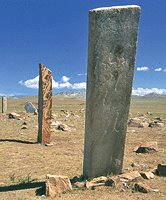 When Genghis Khan set out to unify the Mongolian tribes in the thirteenth century, the man whose ruthless ambition would bind most of Eurasia into the greatest empire in history began with the tribes of an obscure northern valley, the Darkhat. Today lying near the border with Siberian Russia, the Darkhat Valley marks the boundary between the vast central Asian steppe and the forested Siberian taiga. From the earliest times, this region has been a crossroads, a place where the worlds of Central Asia and the Arctic met. The result is a landscape littered with dramatic archaeological monuments, especially huge rock burial mounds known as khirigsuurs and upright stones carved with mysterious symbols.
When Genghis Khan set out to unify the Mongolian tribes in the thirteenth century, the man whose ruthless ambition would bind most of Eurasia into the greatest empire in history began with the tribes of an obscure northern valley, the Darkhat. Today lying near the border with Siberian Russia, the Darkhat Valley marks the boundary between the vast central Asian steppe and the forested Siberian taiga. From the earliest times, this region has been a crossroads, a place where the worlds of Central Asia and the Arctic met. The result is a landscape littered with dramatic archaeological monuments, especially huge rock burial mounds known as khirigsuurs and upright stones carved with mysterious symbols.It's likely that Bronze Age nomads erected these graceful and mysterious megaliths throughout the northern regions of Mongolia and southern Siberia around 1000 B.C., though some scholars think they may be the work of later, Iron Age peoples who appeared by 700 B.C. Known as deer stones for their carved depictions of flying deer, the monuments rival Europe's megaliths in their intricate designs and careful craftsmanship. Just why they were created and what role they played in ancient nomadic cultures are two of the many puzzles in Mongolian archaeology.
Tag : Mongolia, Asia, Archaeology.